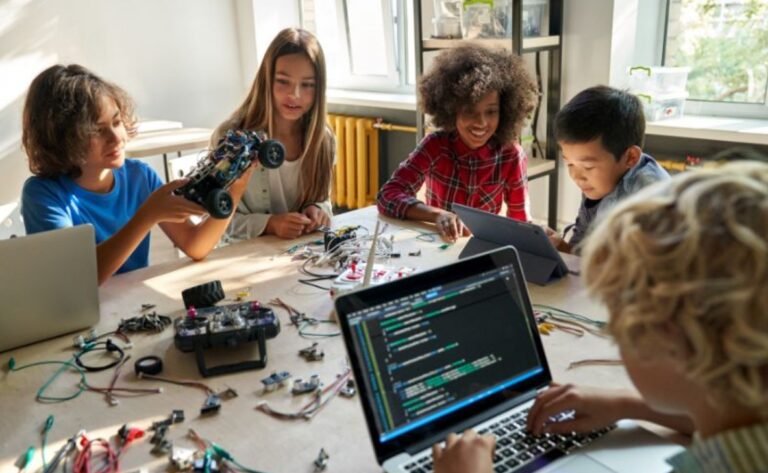Education has always been a dynamic field, evolving with each technological advancement. One of the most transformative innovations shaping classrooms today is Generative AI in Education. Unlike traditional educational technologies, generative AI does not simply assist with administrative tasks or provide static resources. Instead, it actively generates content, ideas, and personalized learning experiences that can revolutionize the way teachers teach and students learn.
Understanding Generative AI in Education
Generative AI in Education refers to artificial intelligence systems capable of creating new content based on data inputs. This includes text, images, simulations, lesson plans, and even assessments. AI tools such as large language models, AI-driven simulators, and content generators are now increasingly used in classrooms and online learning environments. Their primary strength lies in their ability to produce tailored educational experiences for learners with different needs and learning styles.
For instance, a teacher can use AI to generate multiple examples of math problems, customized reading materials, or interactive science simulations. This capability significantly reduces the time educators spend on preparation while improving the variety and quality of instructional materials.
Personalized Learning Experiences
One of the most impactful applications of Generative AI in Education is the creation of personalized learning experiences. Traditional classroom instruction often follows a uniform pace, which can disadvantage students who learn faster or require additional support. Generative AI can analyze individual student data, such as performance metrics, learning history, and preferred learning styles, to generate customized exercises and feedback.
For example, in a language class, AI can generate writing prompts tailored to a student’s vocabulary level and provide instant feedback on grammar and structure. Similarly, in STEM subjects, AI can create adaptive problem sets that adjust in difficulty based on a learner’s mastery. This level of personalization ensures that every student receives support suited to their unique needs, improving both engagement and outcomes.
Supporting Teachers and Reducing Workload
Teachers often spend substantial time developing lesson plans, grading assignments, and providing feedback. Generative AI in Education can alleviate this workload by automating content creation and assessment tasks. AI can draft quizzes, design interactive activities, and even provide initial grading or feedback. While human oversight remains essential to ensure quality and ethical standards, these tools allow educators to focus more on fostering critical thinking, mentoring students, and cultivating creativity.
Additionally, generative AI can serve as a professional development partner for teachers. It can suggest innovative teaching strategies, summarize the latest research in pedagogy, and even generate examples of effective classroom interactions. This continuous support enables teachers to enhance their instructional methods and remain current with evolving educational trends.
Enhancing Collaboration and Creativity
Beyond personalization, Generative AI in Education fosters collaboration and creativity among students. AI-powered tools can assist students in brainstorming ideas for projects, composing essays, or designing multimedia presentations. For group work, AI can help teams organize tasks, simulate project scenarios, and provide feedback on collaborative efforts. This not only enhances learning outcomes but also prepares students for real-world challenges that require teamwork and innovative thinking.
For instance, art and design students can use AI to generate multiple design concepts quickly, allowing them to explore creative directions they might not have considered otherwise. In literature classes, AI can suggest plot developments or character traits to inspire students’ storytelling efforts. These applications encourage experimentation, critical analysis, and originality.
Bridging Educational Gaps
A significant challenge in education worldwide is ensuring equitable access to quality learning. Generative AI in Education can help bridge this gap by providing scalable, high-quality educational resources to students regardless of their location or socioeconomic background. Online platforms equipped with generative AI can deliver interactive lessons, personalized tutoring, and instant feedback to remote or under-resourced learners.
Furthermore, AI-powered translation and content adaptation tools enable students from diverse linguistic backgrounds to access materials in their preferred language, enhancing comprehension and inclusion. By reducing barriers to learning, generative AI contributes to more equitable educational opportunities globally.
Ethical Considerations and Responsible Use
While the benefits of Generative AI in Education are substantial, its implementation must be guided by ethical principles. Data privacy, bias, and academic integrity are critical concerns. AI systems require access to student data to provide personalized learning, which necessitates robust safeguards to protect sensitive information. Additionally, educators must ensure that AI-generated content is accurate, unbiased, and culturally appropriate.
Another ethical consideration is preventing over-reliance on AI. Students should develop independent thinking, problem-solving, and research skills rather than merely accepting AI-generated solutions. Teachers play a vital role in integrating AI responsibly, using it as a tool to enhance learning rather than replace critical human judgment.
The Future of Generative AI in Education
The potential of Generative AI in Education is vast and continues to grow as AI technologies evolve. Future classrooms may feature AI-driven virtual tutors, dynamic lesson generators, and immersive learning simulations. These tools will not only enhance academic achievement but also cultivate essential skills such as creativity, adaptability, and collaboration.
Moreover, the integration of AI into educational policy and curriculum design can support data-informed decision-making. By analyzing learning patterns and outcomes, AI can provide insights that help schools and educational authorities optimize instructional strategies and allocate resources more effectively.
Conclusion
Generative AI in Education is reshaping the educational landscape by providing personalized learning, supporting teachers, fostering creativity, and promoting equity. While challenges such as ethical use and data privacy remain, the thoughtful integration of AI tools promises a future where learning is more engaging, inclusive, and effective. Embracing generative AI responsibly allows educators and students alike to unlock new levels of potential, transforming classrooms into dynamic spaces of exploration and innovation.

